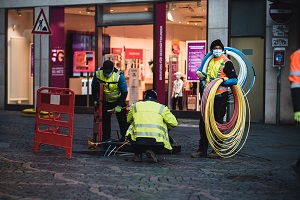Recently, I had one of the most frustrating days at work that I think I have ever had. Why? Because the internet that I rely on was not working. It wasn’t not working for just me, but for a number of people working nearby. That got me thinking about what happens when things stop working? What do you do? Do you stop and take time to think about what has gone wrong? Do you simply panic and jump on the first solution that you can think of?
So, I was having a day working from home, getting ready for a workshop that I was due to co-host in an hour’s time – one minute everything was working well, the next minute, broadband just stopped working. After spending some time running up and downstairs checking connections and hubs, nothing was working. I checked with some neighbours, and everyone using the same provider as me had the same issue. T’internet was off!
Thinking that the problem – whatever was causing it would be dealt with quickly, I thought, the best thing I could do was to use my mobile hotspot to at least be able to do what I needed to do for the workshop I was helping with. Thankfully, I was just helping and not actually hosting. The hotspot did not work very well (I’m being kind here).
This got me thinking – what do we do when something stops working and it is within our control? What happens when you hit a problem with one of your processes that prevents you getting something done? There are two options, firstly, you can react to the problem, throw quick-fix solution(s) in place and keep going, using the same fix every time (or even adding new ones). Or you can take a step back, look at the process overall and then look at what is causing the problem in the first place and find a solution that will prevent the problem happening to begin with. Do some problem solving.
When something stops you in your tracks, you are likely to initially work around the problem, think of something quickly that will allow you to carry on and finish what you are doing. It is human nature to think of how to navigate obstacles. This is fine initially, but if the problem or issue keeps happening and you keep working around, then this often becomes part of your process. The ‘quick fix’ rapidly becomes ingrained in your process. You are still able to complete the task, which is good, but as a result, you have added several steps to the overall process, which is not so good. You are also unlikely to come up with the best solution.
It is better to take a step back and dig down into the root cause of the problem and put things in place to stop the problem happening in the first place – fix the right thing. This is not as easy to do but is the more beneficial of the two options.
A useful method for this is called ‘Creative Problem Solving’ which can provide effective results to assist you in you getting to the bottom of what is causing the problem(s) in your process and coming up with solutions that you can put in place to not only stop the issues happening, but also maybe improve your process, making it better than before.
I’ll talk more about Creative Problem Solving (CPS) in another blog post, but for now, I challenge you to think about the things where you are finding workarounds to complete a process, the things that are causing you issues, the things that annoy you and you wish you could fix. Can you work out what is actually the root cause and prevent it from happening in the first place?
 Oh – and the broadband problem? Lasted 24 hours! It was stressful, yes it interrupted me watching something I really wanted to on tv that night, yes it prevented my kids from watching YouTube (silver linings), but I am pretty confident that the engineer fixed the root cause. Well, I hope so anyway, I can’t face another broadband outage!
Oh – and the broadband problem? Lasted 24 hours! It was stressful, yes it interrupted me watching something I really wanted to on tv that night, yes it prevented my kids from watching YouTube (silver linings), but I am pretty confident that the engineer fixed the root cause. Well, I hope so anyway, I can’t face another broadband outage!
Look out for a blog on the Creative Problem Solving technique by Graham Ross and another one from me on a CPS case study.


